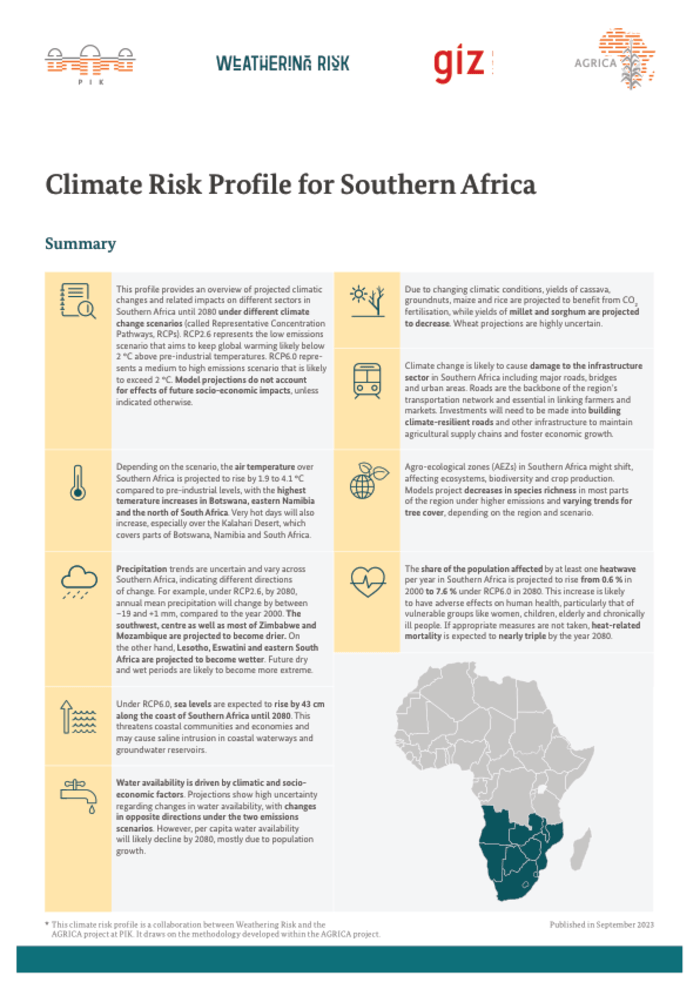Attachments
Summary
This profile provides an overview of projected climatic changes and related impacts on different sectors in Southern Africa until 2080 under different climate change scenarios (called Representative Concentration Pathways, RCPs). RCP2.6 represents the low emissions scenario that aims to keep global warming likely below 2 °C above pre-industrial temperatures. RCP6.0 represents a medium to high emissions scenario that is likely to exceed 2 °C. Model projections do not account for effects of future socio-economic impacts, unless indicated otherwise.
Depending on the scenario, the air temperature over Southern Africa is projected to rise by 1.9 to 4.1 °C compared to pre-industrial levels, with the highest temperature increases in Botswana, eastern Namibia and the north of South Africa. Very hot days will also increase, especially over the Kalahari Desert, which covers parts of Botswana, Namibia and South Africa.
Precipitation trends are uncertain and vary across Southern Africa, indicating different directions of change. For example, under RCP2.6, by 2080, annual mean precipitation will change by between –19 and +1 mm, compared to the year 2000. The southwest, centre as well as most of Zimbabwe and Mozambique are projected to become drier. On the other hand, Lesotho, Eswatini and eastern South Africa are projected to become wetter. Future dry and wet periods are likely to become more extreme.
Under RCP6.0, sea levels are expected to rise by 43 cm along the coast of Southern Africa until 2080. This threatens coastal communities and economies and may cause saline intrusion in coastal waterways and groundwater reservoirs.
Water availability is driven by climatic and socioeconomic factors. Projections show high uncertainty regarding changes in water availability, with changes in opposite directions under the two emissions scenarios. However, per capita water availability will likely decline by 2080, mostly due to population growth.
Due to changing climatic conditions, yields of cassava, groundnuts, maize and rice are projected to benefit from CO2 fertilisation, while yields of millet and sorghum are projected to decrease. Wheat projections are highly uncertain.
Climate change is likely to cause damage to the infrastructure sector in Southern Africa including major roads, bridges and urban areas. Roads are the backbone of the region’s transportation network and essential in linking farmers and markets. Investments will need to be made into building climate-resilient roads and other infrastructure to maintain agricultural supply chains and foster economic growth.
Agro-ecological zones (AEZs) in Southern Africa might shift, affecting ecosystems, biodiversity and crop production.
Models project decreases in species richness in most parts of the region under higher emissions and varying trends for tree cover, depending on the region and scenario.
The share of the population affected by at least one heatwave per year in Southern Africa is projected to rise from 0.6 % in 2000 to 7.6 % under RCP6.0 in 2080. This increase is likely to have adverse effects on human health, particularly that of vulnerable groups like women, children, elderly and chronically ill people. If appropriate measures are not taken, heat-related mortality is expected to nearly triple by the year 2080.
Disclaimer
adelphi
“Weathering Risk” series should say so in title
Source link : https://reliefweb.int/report/angola/climate-risk-profile-southern-africa
Author :
Publish date : 2023-11-29 03:00:00
Copyright for syndicated content belongs to the linked Source.
